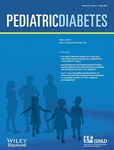Metabolic inflexibility and insulin resistance in obese adolescents with non-alcoholic fatty liver disease
Abstract
Background
Non-alcoholic fatty liver disease (NAFLD) is a comorbidity of childhood obesity.
Objective
We examined whole-body substrate metabolism and metabolic characteristics in obese adolescents with vs. without NAFLD.
Subjects
Twelve obese (BMI ≥ 95th percentile) adolescents with and without NAFLD [intrahepatic triglyceride (IHTG) ≥5.0% vs. <5.0%] were pair-matched for race, gender, age and % body fat.
Methods
Insulin sensitivity (IS) was assessed by a 3-h hyperinsulinemic–euglycemic clamp and whole-body substrate oxidation by indirect calorimetry during fasting and insulin-stimulated conditions.
Results
Adolescents with NAFLD had increased (p < 0.05) abdominal fat, lipids, and liver enzymes compared with those without NAFLD. Fasting glucose concentration was not different between groups, but fasting insulin concentration was higher (p < 0.05) in the NAFLD group compared with those without. Fasting hepatic glucose production and hepatic IS did not differ (p > 0.1) between groups. Adolescents with NAFLD had higher (p < 0.05) fasting glucose oxidation and a tendency for lower fat oxidation. Adolescents with NAFLD had lower (p < 0.05) insulin-stimulated glucose disposal and lower peripheral IS compared with those without NAFLD. Although respiratory quotient (RQ) increased significantly from fasting to insulin-stimulated conditions in both groups (main effect, p < 0.001), the increase in RQ was lower in adolescents with NAFLD vs. those without (interaction, p = 0.037).
Conclusion
NAFLD in obese adolescents is associated with adverse cardiometabolic profile, peripheral insulin resistance and metabolic inflexibility.




